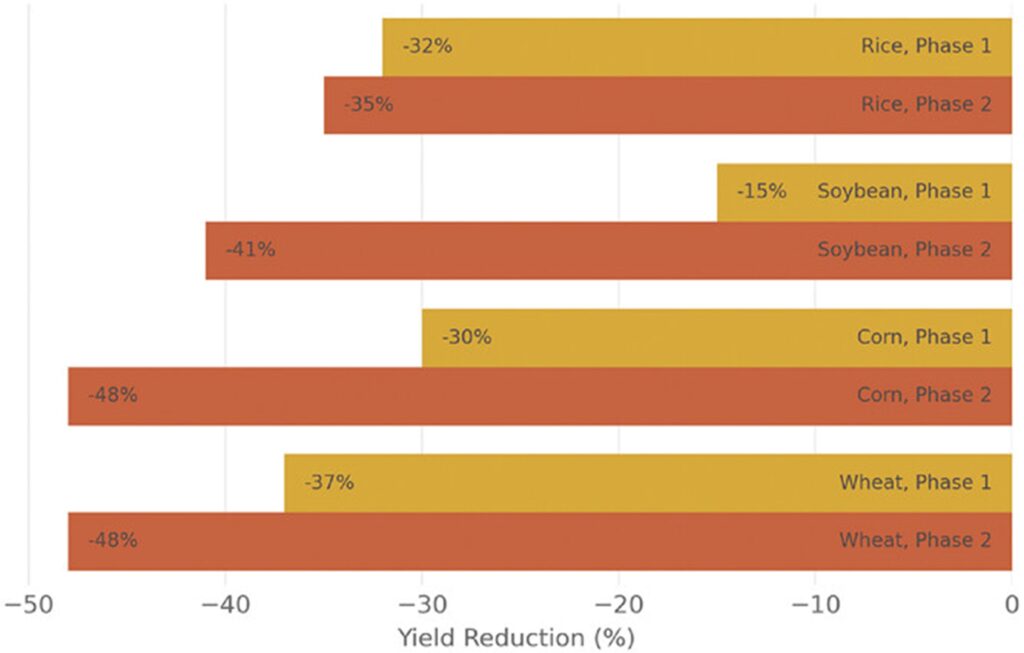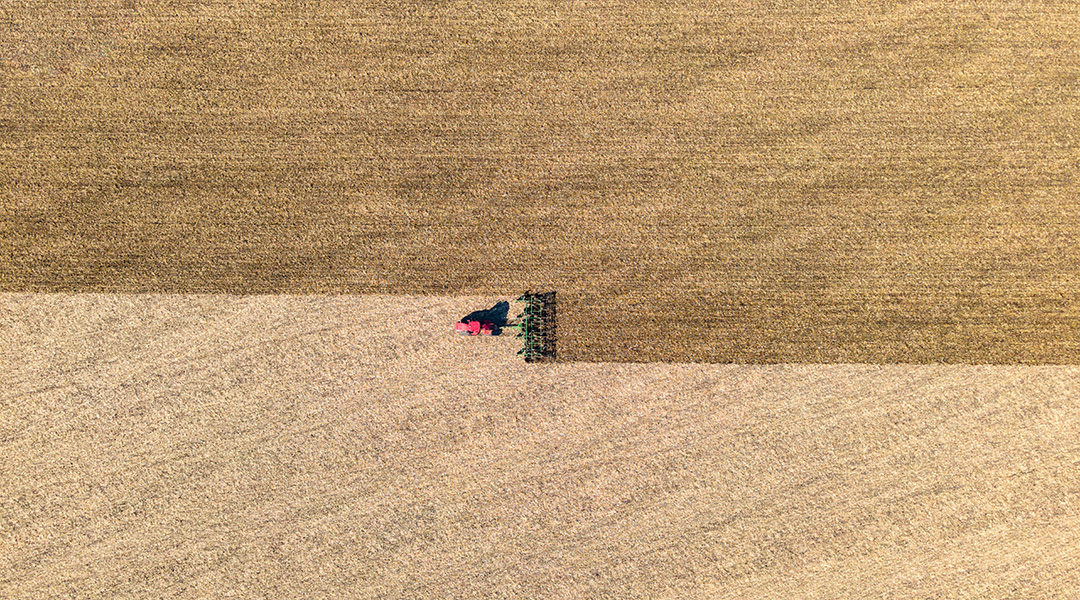In the 21st century, humanity is being confronted with a “polycrisis” of intersecting global issues. According to a team of researchers in Germany, New Zealand, and the United States, a sudden global-scale emergency that disrupts the electrical grid — like a nuclear war, solar storm, or large-scale cyber attack — could lead to massive crop yield losses of up to 75%.
“This highlights how vulnerable modern agriculture is to a collapse in energy supplies,” Florian Ulrich Jehn, one of the study’s authors from the Justus Liebig University Giessen, stated in a press release. Jehn is currently a data science lead for the Alliance to Feed the Earth in Disasters (ALLFED), whose mission is “to feed everyone, no matter what”.
Just how badly a crop or geographical region would be impacted depends on multiple intertwining factors, which can have a ripple effect on the rest of the world. A disaster in a “breadbasket” region — Central Europe or the United States — could quickly turn into a global catastrophe.
How much would agricultural yields decrease?
In their study, the researchers constructed a statistical model to determine how agricultural production would be affected following a serious global event. According to their calculations, crop yields would decrease by up to 37% on average in the first year after the disaster and up to 48% in the second year, when all stocks were depleted.
“We applied a generalized linear model, a statistical tool for understanding how things affect what we want to predict,” Jehn explained in an email.
They modeled yields of corn, rice, soybean, and wheat, which account for most of the protein and calories in the human diet. Their analysis found that the use of machinery, fertilizer, irrigation, and pesticides had the biggest influence on crop yields, so they built their model using data on these factors from publicly available datasets.
“We plugged in our data to create the model, helping us see how much each factor affects the predicted yield,” Jehn said. “Once we understand each factor’s impact, we can use the model to predict outcomes by adjusting these factors. As an example, we set the pesticide factor to zero to see how much yields might decrease without using pesticides.”
The researchers divided the aftermath of the catastrophe into two phases. In Phase 1, the first year, they assumed that some industrial production would still be possible. Diesel fuel would still be available to power agricultural machinery, while fertilizers and manure would be available in reduced quantities.
In Phase 2, the second year, they assumed all stocks would be exhausted. Livestock would be used for work purposes and as a source of manure, and people would transition to a mainly vegan diet.

Among the four crops, soybean was the most resilient overall, particularly in Phase 1. This is because soybeans can fix nitrogen from the air, which could be essential to maintaining nitrogen availability in the soil if industrial fertilizers are no longer an option. Corn, which heavily depends on irrigation, and wheat, which relies on pesticides, were the most vulnerable, with yield reductions reaching 48% in Phase 2.
How much corn yield decreased was also dependent on seed availability. “Corn, in particular, would be severely affected, as the majority of corn crops are grown from hybrid seeds specifically engineered for high one-year performance,” the authors noted in their paper.
The decreases in crop yields also varied by continent. According to the model, Africa would be the least affected — suffering a 26% average yield loss over both phases — followed by Asia at 32%. Europe and South America had similar crop yield reductions of around 25% in Phase 1 and 44% in Phase 2. North America and Oceania were the most severely affected, losing around 30% of their crop yields in Phase 1 and 48% in Phase 2.
“These reductions closely correlate with the current extent of industrialization in agriculture,” the authors stated in the article. “However, yield reduction after a catastrophe would likely be larger than our estimate due to the lack of available data on some relevant factors,” they pointed out. These factors include seed availability, dominant crop varieties, food preservation methods, and farmers’ knowledge.
One way to ease the blow on certain regions could be to decentralize food production, encouraging the spread of smaller food manufacturing companies and distributing food more equally among countries. But what else can be done?
Preventing a global famine
“If an event like the one outlined in our study occurred tomorrow, we would be largely unprepared,” Jehn said.
Currently, ALLFED is studying both low- and high-tech solutions that could help. This includes scaling up farming of resilient foods such as seaweed, constructing more greenhouses, and relocating crops that are tolerant to cool temperatures. Focusing on alternative protein sources is also key as it could be extracted from leaves and grasses and produced from methane or carbon dioxide and hydrogen.
Other preventative measures include bolstering the electrical grid’s infrastructure and simply stockpiling more food, although the latter strategy could potentially increase global food prices and worsen the current food security situation.
Countries should also consider pre-establishing trade agreements and emergency response plans to enhance their level of preparedness. Argentina, for example, has outlined a contingency plan in the event of a nuclear winter.
When asked what the first response should be in the event of a global power grid failure, Jehn said that timing is essential. “If we can get it back in a few months, many of our worst predictions won’t happen. We can start making things like fertilizer and fuel again. If that’s not possible, we have to get ready for a time without machines and key supplies like fertilizers and pesticides in farming.
“We might need to learn from how people used to farm or how small farmers do it today. A lot would change in our society, as more people would have to get involved in farming to make sure we all have enough food.”
Jehn is referring to more traditional farming practices, including smallholder farming, organic farming, and permaculture, which would reduce our reliance on machinery, fertilizers, and pesticides.
Justus Wesseler, a professor and chair of the Agricultural Economics and Rural Policy Group at Wageningen University, The Netherlands, and who was not involved in the study, doubts the practicality of this approach.
“Organic agriculture is not the solution,” he said. “What is more important is having an economic environment that allows new solutions to be developed. This will allow [us] to make agriculture more responsive to the local conditions.”
“Agriculture is not a command-and-control sector,” he added. “Farm households respond to economic incentives.”
The researchers believe that the first step is to collect more data, which would improve model accuracy. “Better data can help to bridge the knowledge gaps regarding missing factors and to gain a deeper understanding of how both the global food trade and production systems, as well as the economy, would react to such a substantial shock,” they stated in their paper.
Reference: Florian Ulrich Jehn, et al., The Fragile State of Industrial Agriculture: Estimating Crop Yield Reductions in a Global Catastrophic Infrastructure Loss Scenario, Global Challenges (2023). DOI: 10.1002/gch2.202300206
Feature image credit: White Field Photo on Unsplash

















